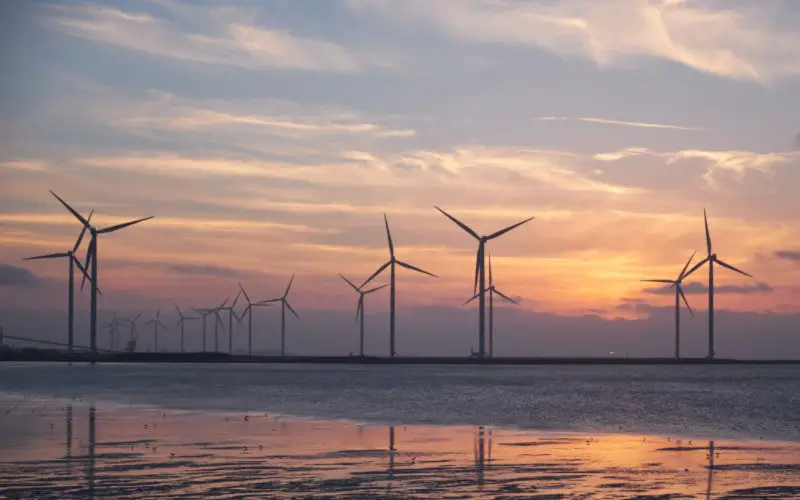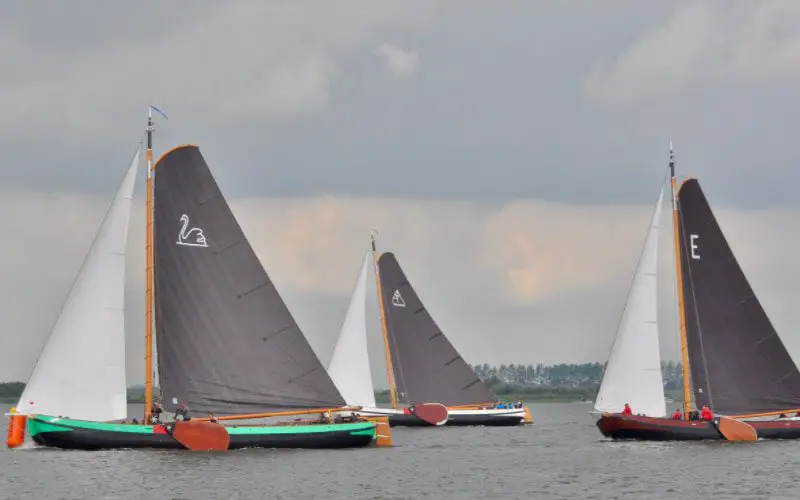

As a Dutchman, I know very well how windy it can be in the Netherlands. You find out about this at a young age when you have to cycle to school. However, since you are so used to it you never really think about it. But why exactly does the wind blow so often in the Netherlands?
Why is the Netherlands so windy? Because the Netherlands is situated by the sea, it is very windy. The Netherlands is also very flat, allowing the wind to pass with no big obstacles. Due to global warming, disturbances occur more often above the oceans. These disturbances are then pushed towards the Netherlands by the current.
The wind can of course be quite annoying when you are cycling. But wind can also be beneficial for a lot of things, such as generating power. It can also give us joy, as a strong wind allows us to be able to kitesurf, sail, or fly a kite on the beach.
The biggest reason why there is so much wind in the Netherlands is due to its geographical location. As you probably know the Netherlands is largely situated by the sea, having a coastline of 450 km (279 miles). This allows the wind that forms far away above the oceans to easily enter the Netherlands.
It also depends on the time of the year. On average, the wind blows harder in the winter and autumn than it does during summer and spring. This is due to large variations in temperatures in the areas where the wind is formed. Because of this the air pressure changes, hence an increase in wind strength.
Because the Netherlands is one of the flattest countries in the world, the wind doesn’t pass many obstacles. Take the Ijsselmeer for example. This large (1133 km² or 704 mi2) lake is located between Noord-Holland and Friesland. This enormous flat area makes it easy for the wind to reach inland.
Compared to the past, it is a lot less windy than it used to be in the country. Because the population density of the Netherlands keeps increasing, more new buildings are built. With all these tall buildings in its way, the wind has more obstacles to pass compared to former days.
Research has shown that the wind is at its mildest in the South-East of the Netherlands. This is because that region is located far away from the coast and is less flat than most other parts of the Netherlands.
View of a windmill in The Netherlands:
Many tourists visiting Amsterdam think that it is always windy in the city. This is often true, and there are a few simple reasons for that.
When you walk through Amsterdam, you probably don’t realize that Amsterdam is only 32 kilometers (19 miles) away from the sea at a crow-fly distance. In other words, the coast is quite close by.
This is one of the reasons why it’s often so windy in Amsterdam. In addition, the land is also quite flat between Amsterdam and the coast. Because of this, the wind only has a few obstacles to pass before it reaches the city.
Another reason why it is so windy in Amsterdam is the buildings. These can have an influence on the wind in certain areas of the city. Since Amsterdam is a large city with many tall buildings, this can definitely be a factor in areas with high-rise buildings.
When the wind hits the top of these buildings it is pushed into different directions, also downwards. Because of this the wind reaches the ground and can cause strong gusts of wind.
Because it is so windy in the Netherlands, people have found ways throughout the centuries to make clever use of the wind. Many of these old ways are now being carried out by machines. But even today, the Netherlands still knows how to make the best use of the wind.
Wind turbines in a tulip field:
Wind energy:
Nowadays, the Netherlands tries to use increasingly more green energy while also trying to reduce the use of fossil fuels. This has led to enormous growth in the usage of wind energy in the last 25 years.
Due to the perfect location and a large amount of wind, the Netherlands is the perfect country to produce wind energy. The amount of wind turbines on land is currently staying even. This is because older turbines are being demolished and make way for newer ones. In 1995 there were only 1008 wind turbines on land, as opposed to 2031 turbines in 2019.
The amount of wind turbines in the Dutch waters does increase considerably. Great effort is being put into building several wind farms, just off the Dutch shore. A large number of wind turbines will also be placed across the Ijsselmeer.
The number of wind turbines in the sea will continue to increase considerably in the future, as opposed to the number of wind turbines on land. Currently (2020), there are 289 wind turbines placed off the Dutch shore. The goal is to reach a total of 1.100 turbines by 2030, which then have to feed 45% of the current rate of energy that the Netherlands requires.
The old Windmills:
Across the globe, the Netherlands is famous for its windmills. Everyone knows the images of the Zaanse Schans and the Kinderdijk.
Mills have been very important to the Netherlands in the past. They were originally used to create more landmass in the Netherlands. By utilizing the wind, mills were able to pump out water. This way the Netherlands was able to create large pieces of land. Nowadays, most of these windmills have been replaced by machines and serve mainly as a place of interest.
Besides the mills that were used to pump out water, there were also a couple of other types of mills. For example, the Dutch golden age mills, which were used to saw wood from Scandinavia. This wood was then used to build ships.
Mills were also used to grind grain in order to make our bread. Some of these mills still operate today. Many of these mills also used to grind malt, which was used by breweries to make beer.
Unfortunately, many mills have been demolished throughout time, and there are only a handful of traditionally operated mills left. To see these beautiful machines with your own eyes, a visit to the Zaanse Schans or Kinderdijk is definitely recommended.
Picture of Dutch windmills:
The simple answer to this question is: no. According to Dutch weather experts, it almost impossible for the Netherlands to get hit by a hurricane. This is because hurricanes often occur in areas where the temperature of the seawater is warm, and where there is little wind.
This does not apply to the Netherlands of course, where it is often very windy and the seawater is usually very cold. The Netherlands can however get hit by the remains of a tropical storm, although these are usually reduced in strength and don’t tend to cause large amounts of damage.
Of course, it can still storm in the Netherlands. The fastest wind speed ever recorded in the country was 161 km/h (100 mph). This is, however, a very extreme case that hardly ever occurs.
Although the wind can be quite dangerous or annoying, there are moments when it can make for great fun. Below you will find five of the nicest activities you can do when it is windy.
Sailing:
If you love to sail, the wind can be your greatest friend. Without the wind, you will not be able to move forward. In the Netherlands, there are many opportunities to sail. You can sail on one of the large lakes in Friesland, but sailing at sea is also very popular. This is, however, done more often by professional sailors. The sea around the Netherlands can be very treacherous, so make sure you know what you’re doing.
Typical Dutch sailing boats:
Gliding:
Gliding is also a spectacular way to make use of the wind. You will be lifted into the air using a winch, all while seated inside a plane without engines. Once you’re up, the plane will continue to glide through the air by making use of the multiple air currents.
It is not possible to just enter a glider. There are many strict rules set out for this. It is however possible to fly in a two-person glider. You can do this at one of the many gliding clubs in the Netherlands. There are currently around 40 of these clubs.
Kitesurfing:
For the ‘real’ thrill-seekers, there is also kitesurfing. You shoot across the water at high speeds while executing very high jumps. This sport is practiced a lot during the summer in the Netherlands. One of the best kiters in the world is actually from the Netherlands.
Kitesurfing is not a sport you can just learn in a day. It requires a lot of time to get a good grip at it. There are however kite schools in the Netherlands where you can take lessons. Just don’t think that one lesson will be enough.
Flying a kite:
This is one that everyone can do: going to the beach to have a fun day with the family and flying a kite together. Not much practice is required and children can also join in on the fun. All you need besides a kite is the wind.
Kitebuggy:
This is a relatively new sport in the Netherlands. You are seated in a buggy that is being pulled by a large kite. It is possible to reach high speeds and can be quite spectacular.
This activity is nowadays very popular at bachelor parties, mainly because it is fast to learn and gives an adrenaline rush.
Besides these five activities, there are of course many more activities you can do using the wind. For instance, what about windsurfing, flying hot air balloons, or paragliding?
There are more benefits that the wind brings along than just the ones above, some of which you may not instantly think of.
Wash:
One of the simplest – yet most handy benefits of the wind is of course that dries the laundry on the washing line. Together with the sun, the wind makes sure that your laundry dries in the most eco-friendly way.
Birds:
The wind is also used a lot by birds in the sky. Just like gliders, some birds glide through the skies using several air currents. This way, they are capable of traveling for great distances.
Plants:
Plants also benefit considerably from the wind. For example, many plants get pollinated thanks to the wind carrying the pollen over to other plants. Because of this, plants can produce more fruits and seeds.
By reading this blog, I hope that you got to know more about the wind in the Netherlands. Why it is so windy in the Netherlands, how the Netherlands utilizes the wind, and what fun activities you can do when it is windy.
Just like the wind, the sea level is also affected by climate change. Does this mean that The Netherlands is underwater? Read our blog on this topic now, it ties in perfectly with this blog.